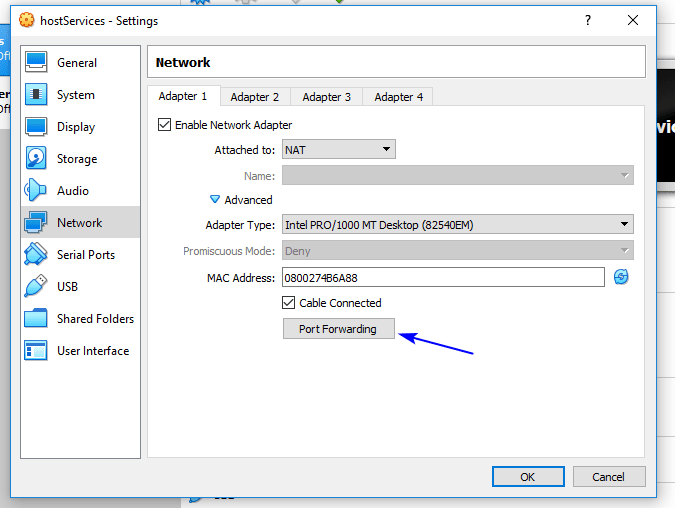

- #HOW TO SETUP PRIVATE NETWORK IN VIRTUALBOX LINUX INSTALL#
- #HOW TO SETUP PRIVATE NETWORK IN VIRTUALBOX LINUX PRO#
- #HOW TO SETUP PRIVATE NETWORK IN VIRTUALBOX LINUX SOFTWARE#
- #HOW TO SETUP PRIVATE NETWORK IN VIRTUALBOX LINUX ISO#
- #HOW TO SETUP PRIVATE NETWORK IN VIRTUALBOX LINUX SERIES#
Other packages you need should be installed using the apt-get program later.
#HOW TO SETUP PRIVATE NETWORK IN VIRTUALBOX LINUX SOFTWARE#
Software selection: “standard system utilities” will be selected by default, so just hit Enter. Write to disk (again): “No” will be selected by default choose “Yes”. Write partition changes to disk: “No” will be selected by default choose “Yes”. Remember it, because you’ll need it to log in or run administrative commands on the virtual machine. Password: Enter and confirm a password. Username: Your user name, which should be short, one word, and all lower case (e.g. Hostname: “hostcom” (or another all-lower-case network name for your server). Go through the menus to configure Ubuntu, leaving all values at the default except the following (don’t include quotation marks):. The virtual machine will boot, and the Ubuntu installer will load. Back at the dialog, click “Start” to start the virtual machine. #HOW TO SETUP PRIVATE NETWORK IN VIRTUALBOX LINUX ISO#
iso file to previously, select the file, and click “Open”. Click the folder icon, navigate to the folder you downloaded the.
Another dialog should appear, basically saying we need to “insert” the installation media. Back at the main VirtualBox window, select your new virtual machine from the list of machines, and click the “Start” button in the toolbar to “power it on”. We’re going to do the virtual equivalent of that now. #HOW TO SETUP PRIVATE NETWORK IN VIRTUALBOX LINUX INSTALL#
If it were a physical computer, we’d pop in a CD or other installation media, which would allow the machine to boot and install an operating system to its hard drive. There’s no operating system for it to boot with. Now you have a virtual machine, but its virtual hard drive is empty.
Click the “Create” button in the wizard to create your new virtual machine. Name: This can be whatever you want, but since we’re simulating a server at our hosting company, we’re going to use the name “hostcom”. Go through the wizard dialog to configure the new virtual machine, leaving all values at the default except the following:. Launch VirtualBox, and click the “New” button in the toolbar to create a new virtual machine. Now we need to create and configure a virtual machine within VirtualBox. Basically, you’ve just downloaded a virtual Ubuntu installation CD. Make note of the folder it gets downloaded to we’ll need to find it in a minute.iso stands for ISO 9660, a standard for representing the contents of CD-ROMs and DVD-ROMs as computer files. 
(Ubuntu is just one of many Linux distributions available, but we’ve chosen Ubuntu because it’s common and relatively easy to use.) You’ll have a choice between the latest version and a “Long Term Support” version choose the LTS version because it’ll be more stable.
Download Ubuntu Server from the Ubuntu downloads page. Run the installer, and follow the directions onscreen. (Yes, you can run Linux as a virtual machine within Linux it’s actually beneficial in many circumstances.) Download VirtualBox for your host OS (Windows, Mac, or Linux) from the VirtualBox downloads page. Download VirtualBox & Ubuntu Serverįirst we need to download and install VirtualBox itself, followed by a Linux installer. Your desktop or laptop is going to be the host system, and we’re going to create a guest system to run Linux on. Think of it as a computer within a computer. We’re going to create a virtual machine to run a Linux server on. #HOW TO SETUP PRIVATE NETWORK IN VIRTUALBOX LINUX PRO#
These directions are available as a video workshop to our Pro students, but we thought we’d share the basic ingredients here as well so you can experiment with Linux servers yourself! This is a great way to try things out because it lets you copy the server to try out different configurations, take snapshots you can roll back to if you make a mistake, and more. So we figured out a setup that mimics a Linux server running out on the Internet somewhere -which is where you’d typically deploy web apps to -but uses VirtualBox to run the server as a virtual machine on your development system.
#HOW TO SETUP PRIVATE NETWORK IN VIRTUALBOX LINUX SERIES#
We’re prepping a workshop series for our Pro students on deploying web apps to production, and we wanted a simple, safe way for students to follow along at home, without having to create an account on AWS / DigitalOcean / etc.






 0 kommentar(er)
0 kommentar(er)
